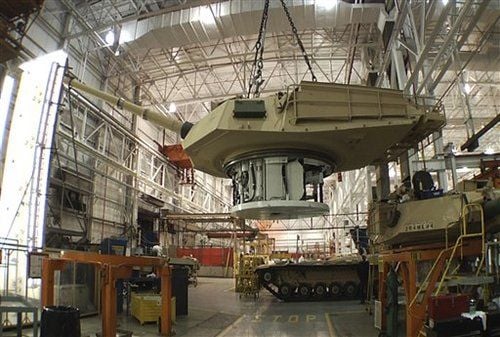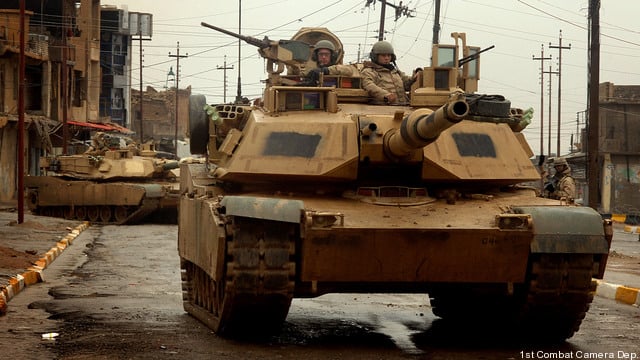Tank Plant Trump Says He Saved Was Never In Danger
Posted on

General Dynamics’ Lima tank plant, the only factory in the US capable of building main battle tanks.
WASHINGTON: President Trump kicked off his speech yesterday at the nation’s last remaining tank manufacturing factory in Lima, Ohio with the boast: “if it weren’t for me, this place woulda been closed.”
Would it really?
While the plant has seen its workforce slashed and production slowed to a relative trickle in recent years, Congress has never once come close to zeroing out tank production during the Obama or Trump administrations, instead lawmakers have repeatedly added funding and rebuffed Army proposals to shut down the line. In fact, funding has been on a steady upswing since 2015 — well before the Trump administration moved in.
The president’s bold claim is the latest chapter in a years-long saga over funding for the Army and Marine Corps’ iconic M1 Abrams heavy tank, funding for which has ebbed and flowed as the nation spent years, and hundreds of billions of dollars, fighting insurgents in up-close fights that rarely required a hulking, 70-ton tank.
What is true is that the Trump administration has dramatically increased funding for the Abrams, as well as the 8×8 Stryker infantry vehicle, also assembled in Lima. That’s allowed General Dynamics to double the size of the workforce from the current 400 to around 1,000 in the coming years.
The first line the president uttered in front of the crowd of plant employees at what is known as the Joint Systems Manufacturing Center, “you better love me, I kept this place open,” set the tone for a riff-heavy address that veered from boasts of a domestic manufacturing resurgence to an extended off-the-cuff explanation of how much Trump had always disliked deceased senator John McCain.
The Army has long been vocal over plans to increased Abrams work in 2017, unveiling a plan back in 2015 to begin awarding contracts to General Dynamics to upgrade the Abrams to what’s called the System Enhancement Package Version 3 (SEPv3) version. The new configuration features huge upgrades in armor, communications, reliability and fuel efficiency. That first production model was delivered in 2017.
The backstory
The long, messy saga involving the Abrams and work at the JSMC kicked off around 2012, when the Army said it planned to shutter the line at Lima from 2014-2016 and then reopen it in 2017, when it would contract with General Dynamics to upgrade its M1 Abrams tanks to the M1A2 SEPV3 configuration.
At the time, then-Army Chief of Staff Gen. Ray Odierno argued with congressional committees determined to keep the Abrams line open that the Army needed to get lighter and spend its money elsewhere. The Abrams tanks played little role in fighting insurgents in Iraq and Afghanistan — with some prominent exceptions in urban combat in places like Fallujah and Sadr City — and the Army was up against budget caps and desperate to save money. The Army said it could save as much as $3 billion by halting M1 work between 2014 to 2016.
“We don’t need the tanks,” Odierno testified. “Our tank fleet is two-and-a-half years old on average now. We’re in good shape and these are additional tanks that we don’t need.”
Odierno lost that particular fight. In 2013, Congress voted to add $183 million for tanks, leading the general to lament, “if we had our choice, we would use that money in a different way.”
But from there on out, the numbers started to rise. By time the 2016 budget hit, the Obama administration requested $368 million for upgrades to the Abrams, up 50 percent from $237 million in fiscal 2015. The 2017 budget saw a request for $558 million for more tanks. But by 2019, that rose to $1.5 billion to upgrade more tanks, followed by 2020’s proposed $1.7 billion.
General Dynamics estimates that JSMC will eventually employ 935 people to produce 34 tanks each month, up from the roughly 400 employees who work there now.
That increase in work comes as the Trump administration increased spending on defense across the board, pushing the 2020 budget request to $750 billion. That number will face some opposition on Capitol Hill thanks to controversial budgeting gimmicks the administration is using to make and end-run around budget caps, but top Democrats have signaled they would be comfortable with something in the $733 billion range.
But when it comes to saving the factory in Lima, rather than a last-minute dramatic gesture from the White House, it was in the plans all along.
Subscribe to our newsletter
Promotions, new products and sales. Directly to your inbox.

